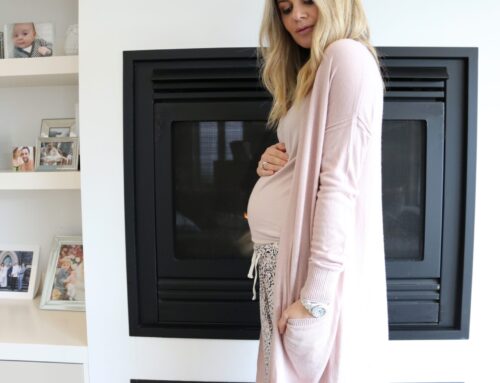Anyone who knows me knows that I haven’t been able to wipe the huge smile off my face since finding out that Snez and I would be welcoming a beautiful baby girl in October this year.
With so many pregnant women on my program and one in my house, I am always asked how (and if) they can remain active and healthy when expecting. Working closely with our pregnancy physiotherapist, Marney Jury, I give all these women (including Snez!) the most accurate information and advice to help them stay safe and active during such an exciting time.
Can you exercise during pregnancy?
In an uncomplicated pregnancy, exercise during all stages is incredibly beneficial and in fact- it’s encouraged. There are so many benefits that come from exercising when pregnant but some of the key ones include: maintaining muscle strength and tone, improving cardiovascular fitness and assisting with mental wellbeing.
There are so many major changes happening to your body during your pregnancy and maintaining and strengthening your muscles will help to counteract some of the aches and pains that come with growing a human. Exercise can help to reduce the risk of pregnancy related pain, such as the dreaded hip, pelvis, back and neck pain and it can actually help you bounce back faster when your bub is born. Maintaining cardiovascular fitness can help you gain a healthy amount of weight, reduce your risk of gestational diabetes, reduce your risk of breathlessness, reduce swelling and puffiness, prepare your body for labour and assist with post-natal recovery so you bounce back faster. Last but certainly not least, we all know how good exercise makes us feel. As those happy endorphins flow in after a workout it can help mums-to-be feel more positive about the incredible changes happening to your body and reduce those feelings of anxiety as your body transforms.
It’s so important to remember that everyone is different and all pregnancies are different, so here are some tips from our pregnancy expert Marney around when, how much and what type of exercise is recommended for mums-to-be.
So, when, how much and what type of exercise?!
All pregnancies are different, factors such as whether it’s your first, second or otherwise pregnancy, your pre-existing fitness level and pregnancy complications affect how you can exercise. Essentially if you are already exercising when you fall pregnant, you are feeling well and have no complications you can continue a similar type and level of exercise throughout your first trimester. As your pregnancy progresses you will need to gradually lower the intensity and impact of your exercise program by listening to your body – we’ll talk more about this later!
The ACOG (American Congress of Obstetricians and Gynecologists) guidelines recommend 150 minutes of moderate intensity exercise per week during pregnancy. This equates to around 30mins on 5 days per week. So let’s say 28 minutes a day.
Moderate intensity exercise is exercise that raises the heart rate and induces a sweat but allows you to maintain speaking in full sentences. The only exercises they recommend avoiding in the first trimester are contact sports and sports that have a high risk of falling such as skiing.? During the second and third trimester it is likely you’ll need to avoid jumpy and jerky exercises and heavy weights which increase the pressure on your pelvic floor and force through your back and pelvis.
STAY ACTIVE WHILE STAYING SAFE
Whilst my program is safe for pregnancy there are certainly some signs & symptoms to look out for that mean you should take a break, make a modification or stop your exercise or workout altogether. I sat down with Marney to talk about the warning signs and what these may mean for you.
Light headedness, dizziness, nausea: ?If you experience light headedness, dizziness or nausea this could be a sign that your blood pressure or blood sugar levels may be low. You could also be overheating and should allow yourself to recover from this by allowing yourself to rest, making sure you are well hydrated, exercising in a comfortable climate (somewhere not too hot) and by making sure that you are well nourished. If these symptoms pass quickly you may recommence exercise at a lower intensity however you may need to change your position or the room temperature.
As you get further into your pregnancy and head into the second trimester lying flat on your back for extended periods of time can cause these symptoms if the pressure/weight of your growing uterus to compress your major arteries. This is an indication you should change position – sidelying, standing or sitting may be better for you going forward! If you feel comfortable and have no symptoms doing safe exercises on your back for a short period of tme it’s okay to continue. Generally it becomes more uncomfortable as your belly gets bigger around or beyond 20 weeks.
Pain or discomfort
Exercise isn’t always going to be comfortable but you need to be able to identify if what you are doing is potentially dangerous. If an exercise or particular position causes you pain or discomfort during or after you perform it, particularly around your pelvis, pubic symphysis, hips or low back you should modify or cease the exercise. Exercises in a split leg (similar to a lunge) or single leg standing position may become uncomfortable as the strong ligaments that help to stabilise the pelvis become lax. In this case you should ensure you are lifting your pelvic floor and tightening your core muscles or modify to symmetrical stance position.
Abdominal separation:? If you notice a “doming” bulge down the centre of your abdomen during a movement or position you should modify the movement to eliminate the dome by drawing your tummy muscles in or ceasing the movement/position. The doming indicates you are putting pressure on the connective tissue that joins your abdominus recti muscles (6 pack muscles) down the centre and can increase the risk or amount of abdominal muscle separation. Separation of the abdominal muscles is a completely normal phenomena when rapid expansion of the uterus puts too much pressure on the connective tissue that connects the abdominal muscles. By ensuring you maintain strength in the underlying core muscles (transverse abdominus and obliques) you can limit the amount of separation and ensure your back is well supported and protected. Your health professional or physiotherapist can help to teach you more about this.
Pelvic Floor Pressure:? We’ve all heard the importance of pelvic floor, your key take home messages here are start pelvic floor exercises early and minimise the pressure you put on your pelvic floor! As the weight of your uterus bears down on your pelvic floor the load on this muscle group increases, by minimising the forces transmitted onto the pelvic floor (such as in jumping or heavy weights) and by minimising intra-abdominal pressure by breathing out on effort during an exercise can help protect your pelvic floor.
Following the above advice some recommended exercises include walking, swimming, cycling, low impact weights and bodyweight exercises, tennis, modified yoga and Pilates, pre-natal or clinical pilates. Exercise in a comfortable temperature, smartly, during pregnancy is definitely encouraged! Of course seeking advice from your trusted health professional (GP, obstetrician, physiotherapist, midwife) should you experience ongoing pain, symptoms, bleeding or discharge.
I’m so excited to announce that my complete 28 by Sam Wood Pregnancy program will launch mid-September of this year. The program will have a pregnancy tailored meal-plan, pregnancy safe-workouts and informative and educational ‘On the Couch’ videos talking all things training and nutrition during pregnancy and post-pregnancy. I love having Marney as part of our 28 team of experts and look forward to helping many more mums-to-be stay fit and healthy during such an exciting time.







Leave A Comment